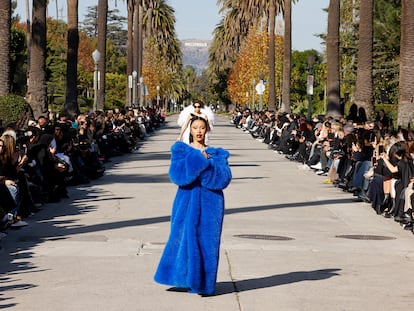The hidden side of fashion’s Cristóbal Balenciaga: From his despotic nature to his relationships with Spanish dictator Francisco Franco’s elites
A new Disney+ series sheds light on the brilliant legacy of Spain’s most celebrated designer of all time, but also hints at the genius’s shadows. Actress Nine d’Urso brings to life the iconic dresses re-created for this biopic
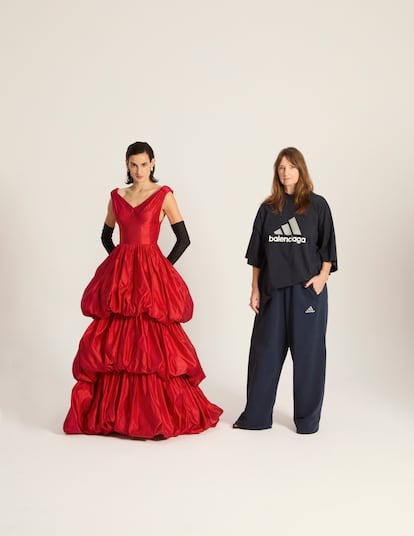
If Cristóbal Balenciaga (Getaria, Spain, 1895-Xàbia, Spain, 1972) were alive today, he would probably refuse to collaborate in the making of a television series about his life. What’s more, he would probably request that the production be “kidnapped” until he could watch it. The most celebrated Spanish designer of all time jealously guarded his privacy, obsessively controlled his creations and his image, and was so discreet that in his own day that it was rumored that he did not actually exist. He never went out to say hello after exhibiting his collections, rarely met with his clients and only gave two interviews in the 50+ years of his career. He detested advertising and being photographed (he made one exception to promote his perfume Le Dix, in 1947) and abhorred public scrutiny of his work and private life. Despite his legendary reclusiveness, or perhaps because of it, he was a celebrity. In 1962, at the height of his career, the newspaper France-Soir published a photograph of the couturier in his white work coat and the caption, “This is Balenciaga, the man of mystery.” A few years later, with the rise of ready-to-wear fashion driven by Yves Saint Laurent and the French May’s wave of youth protests, he announced his retirement from fashion and ordered the closure of his stores and workshops.
Half a century after Balenciaga’s death, little is still known about the man behind the legend, and his figure continues to raise all sorts of questions. The Balenciaga series, which premieres on the Disney+ streaming platform on January 19, begins with a scene that illustrates the couturier’s aversion to answering journalists’ questions. An older Cristobal Balenciaga, played by Alberto San Juan, attends Coco Chanel’s funeral at the Parisian church of La Madeleine and is intercepted by Prudence Glynn, the fashion columnist for the British newspaper The Times; she asks him for an interview. At first, Balenciaga refuses to talk, but eventually she unravels the secrets of his novel rise to fame from the son of a fisherman and seamstress to the father of haute couture with a Spanish accent.
The series —which will be available on Disney+ and Hulu— reflects the couturier’s brilliant legacy, revered by such sacred giants as Christian Dior, Chanel and Hubert de Givenchy. But it also hints at the shadows of his life: his despotic character; his constrained homosexuality and his complex romantic relationship with the Franco-Polish milliner Wladzio Jaworowski d’Attainville; his complicit silence during the occupation of France by Axis forces (many ateliers closed, while his remained open); the betrayal of his partners, Nicolas Bizcarrondo and Virgilia Mendizabal, whom he split from abruptly after achieving success; and his close ties to the elites of dictator Francisco Franco’s regime —Carmen Polo, Carmen Franco and the Marquise of Llanzol, Ramón Serrano Suñer’s lover— were regular clients of his, and in 1972, four years after retiring, he accepted the commission to design the wedding dress of Carmen Martínez-Bordiú, the dictator’s granddaughter.

“We know so little about Balenciaga. He was a closed-off person, and his figure remains so. After retiring, he wanted his fashion to close, and I think he would have kept it that way today,” explains Bina Daigeler, 58, Balenciaga’s German costume designer, in conversation with El País Semanal. “I guess he would hate a series about his life, or maybe he would be flattered. I don’t know,” she continues. Daigeler is one of the industry’s most sought-after costume designers. She has worked with Pedro Almodovar and Jim Jarmusch; the Munich native is a favorite of Cate Blanchett, whom she dressed for the series Mrs. America and the film Tár and was nominated for an Oscar for the film Mulan. However, she admits that she was intimidated by the Balenciaga commission. “When they offered it to me, I had a nervous moment where I said to myself, ‘Oh my God, how am I going to replicate a Balenciaga? How am I going to dare to do this?’ We’re talking about old-fashioned haute couture, the good kind, where everything is handmade,” she confesses. “It was a gigantic challenge, but an appealing one because I started my career as a couturier.”
Bina Daigeler and her co-designer, Pepo Ruiz Dorado, worked against the clock. Disney commissioned the project in January 2022 and shooting began in May of that same year. They had less than six months to document and start producing the costumes in the German costume designer’s workshop in Madrid. The result: about 18 haute couture designs per episode, over 80 pieces that encapsulate the couturier’s milestones: the 1947 tonneau line, the 1951 semi-fitted look and barrel line, the 1953 balloon skirt, the 1955 tunic, the 1957 sack dress, the 1958 baby-doll, the 1960 semi-fitted style, the 1967 envelope dress, Balenciaga’s constant inspiration in the great masters of Spanish painting like Velázquez and Goya and in traditional Spanish garb like the cobijada, the mermaid silhouette and ruffles of folklore and the typical Segovian costume.
“That was the key to this project, replicating Balenciaga’s work in a very short time… under the orders of three different directors, each with their own tastes,” Daigeler says, referring to the trio of filmmakers formed by Aitor Arregi, Jon Garaño and Jose Mari Goenaga. The Balenciaga house opened its doors at number 10 Avenue George V in Paris to them, as well as its archives, the exact location of which is a secret. Miren Arzalluz, the director of the Fashion Museum of the City of Paris, gave them access to Galliera Palace funds, and the Balenciaga Museum in Getaria, Spain, also collaborated with them. They were able to see and photograph Balenciaga’s key dresses, study their details and sculptural forms and examine the ingenious cut of sleeves and collars that turned the wrist and nape of his clients’ wrists and necks into erogenous zones.
During this “re-creation” process, they discovered that it was impossible to make an original Balenciaga dress without using the fabrics of the time. “Cristóbal used fabrics in an architectural way to stylize the female figure. His work was not that of a designer but rather that of an architect. With every outfit, I would ask myself: but how did he do that?” recalls Daigeler. The answer was in the fabrics. The couturier created his own fabric, gazar, produced exclusively for him by the Abraham factory in Zurich. Daigeler and Ruiz Dorado scoured legendary Madrid stores like José María Ruiz and Julián López to rescue original silks, and they also placed orders with Abraham. “And then we made each suit to measure, as he did. He never did prêt-à-porter, everything was haute couture,” says Pepo Ruiz Dorado. “Each dress is for an actress or model in the series, made as he did, with the toile fitting, a second fitting...”
Balenciaga considered himself to be a plastic surgeon who operated through his creations, favoring and enhancing the image of his clients. ”Give me an imperfect body and I will make it perfect,” he used to say. Men often hated his dresses because they were not overtly sexy. But women revered his work. Barbara Hutton, the Duchess of Windsor, Bunny Mellon and Mona von Bismarck were among his most faithful customers. The series shows how a self-conscious Fabiola de Mora y Aragón, played by Belén Cuesta, turns to him for the bridal dress she wore at her wedding to Baldwin of Belgium in 1960. “Women felt gorgeous and powerful in [Balenciaga’s] clothes. And that’s what fashion is all about, empowerment,” Daigeler points out.
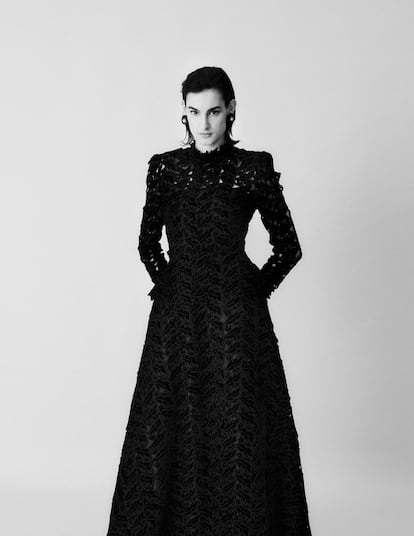
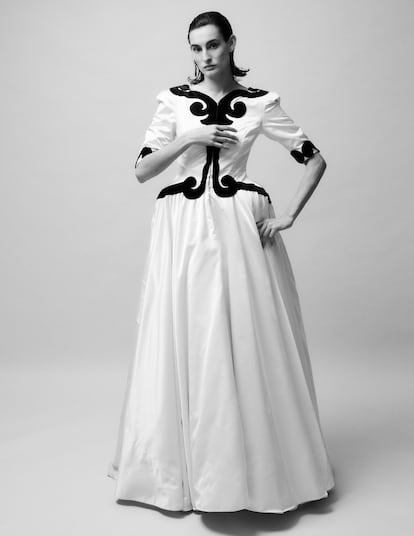
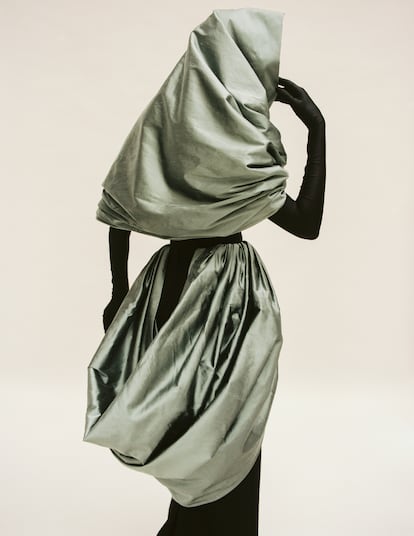
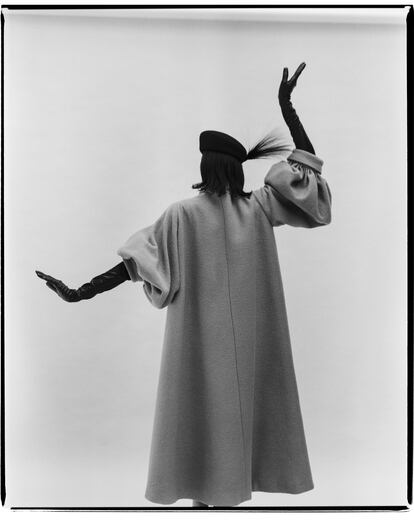
The couturier also revolutionized fashion with a new type of model who embodied his collections. Colette, his first muse in Paris, had a different sort of beauty, and chroniclers described her way of walking down the catwalk as “that of a grenadier who wanted to kill everyone.” French actress Nine d’Urso, 29, brings Colette to life on the screen. “We don’t know much about her. She was with him from 1937 until she died in the 1950s,” explains the actress, who received help from her mother, model Inès de la Fressange, in preparing for her role. “Colette was a bit masculine; she had sharp bones and broad shoulders. She had a slight hump and bony hips, so she moved and posed in a very particular way, like a contortionist. Cristobal was obsessed with her figure and created many silhouettes to flatter her,” the actress notes. “At a time when models were tiny, Balenciaga changed things. He was a visionary and even created a new model of woman.”
In 1973, a year after the designer’s death, the Metropolitan Museum in New York paid tribute to him with an exhibition. The New York Times headlined its review of the exhibit “The Age of Balenciaga: It Seems So Long Ago.” Calvin Klein said that “most of his work seems outdated.” They were wrong. Balenciaga’s name was revived and is now part of the Kering luxury group. His radical ideas about form and structure and his technical innovations in fabric and cut still live on. Demna Gvasalia, Balenciaga’s current creative director, often nods to the fashion house’s archives in his own creations.
Balenciaga wanted his brand to die with him, but that hasn’t happened. He didn’t like being in the spotlight, but now he has his own TV series. “Maybe he would be in shock,” Nine d’Urso admits. “But everyone has worked hard on this project: the directors, Bina, the actors... Balenciaga was obsessive about work and knew how to value effort. I don’t want to speak for him, but maybe he would see all the work behind the series. He might be proud.”
PRODUCTION CREDITS
Sign up for our weekly newsletter to get more English-language news coverage from EL PAÍS USA Edition
Tu suscripción se está usando en otro dispositivo
¿Quieres añadir otro usuario a tu suscripción?
Si continúas leyendo en este dispositivo, no se podrá leer en el otro.
FlechaTu suscripción se está usando en otro dispositivo y solo puedes acceder a EL PAÍS desde un dispositivo a la vez.
Si quieres compartir tu cuenta, cambia tu suscripción a la modalidad Premium, así podrás añadir otro usuario. Cada uno accederá con su propia cuenta de email, lo que os permitirá personalizar vuestra experiencia en EL PAÍS.
¿Tienes una suscripción de empresa? Accede aquí para contratar más cuentas.
En el caso de no saber quién está usando tu cuenta, te recomendamos cambiar tu contraseña aquí.
Si decides continuar compartiendo tu cuenta, este mensaje se mostrará en tu dispositivo y en el de la otra persona que está usando tu cuenta de forma indefinida, afectando a tu experiencia de lectura. Puedes consultar aquí los términos y condiciones de la suscripción digital.
More information
Archived In
Últimas noticias
All the effects of gentrification in one corner of Mexico’s Colonia Roma
Palestinian reporter Youmna El Sayed: ‘My family told me I had to choose between being a journalist or a mother’
The new language of the workplace: Knowing how to ask AI questions is more important than using it
Russell Tovey: ‘I was advised many times not to come out, I don’t think there was many people who’d done that — and I feel really proud that I’m one of those that did’
Most viewed
- Christian Louboutin: ‘Young people don’t want to be like their parents. And if their parents wear sneakers, they’re going to look for something else’
- The low-cost creative revolution: How technology is making art accessible to everyone
- US sanctions against jailed cartel leader ‘El Marro’ highlight Mexico’s lack of control over its prisons
- Liset Menéndez de la Prida, neuroscientist: ‘It’s not normal to constantly seek pleasure; it’s important to be bored, to be calm’
- Cartels in Mexico take a leap forward with narco-drones: ‘It is criminal groups that are leading the innovation race’

